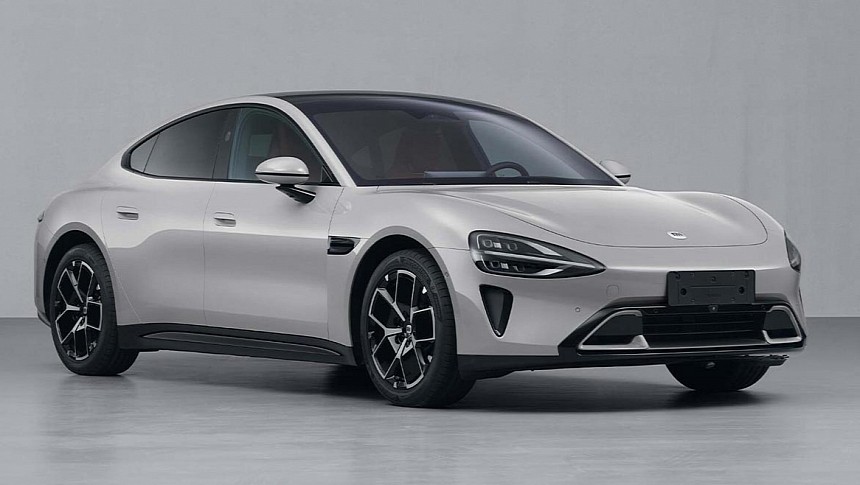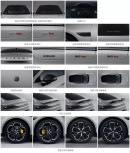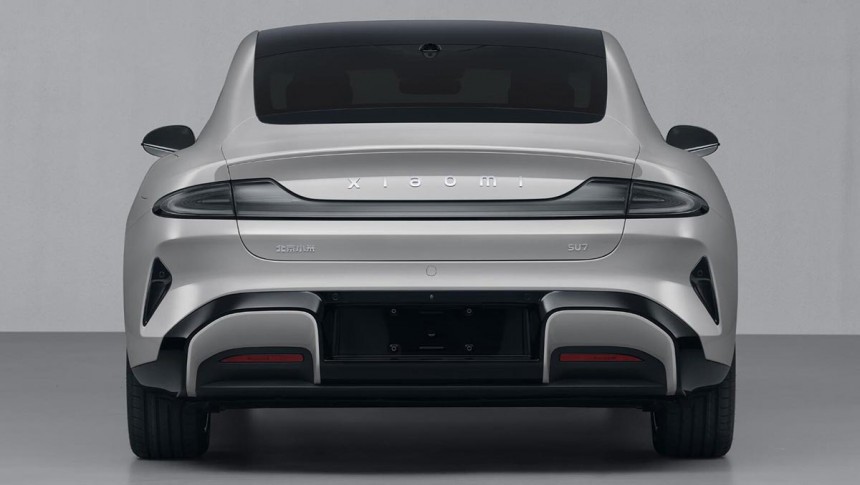Tech giant Xiaomi has just shifted gears and went into the EV market. The first car of the brand is the Xiaomi SU7, and it doesn't really look like a smartphone.
The Xiaomi SU7 is not what it might lead you into believing it is. It is definitely not a smartphone and, even though the name might say otherwise, it is not an SUV, either. The not-an-SUV SU7 is actually a compact sedan, a Tesla Model 3 contender, which was previously known during the development stage under the codename MS11.
The first photos of the car have been revealed by China’s Ministry of Industry and Information Technology, which shared the images accompanied by several details about Xiaomi’s first car as it does with all cars that are to be sold on te local market, before they are unveiled by the carmaker.
The design of the SU7 seems to be a weird combination of the Tesla Model 3 with headlights borrowed from a McLaren and lines transferred from a Porsche Taycan. The model measures 196.7 inches (4,997 millimeters) in length, 77.3 inches (1,963 millimeters) in width, and 56.9 (1,455 millimeters) in height, sporting a wheelbase of 118 inches (3,000 millimeters).
The SU7 tips the scales at 4,365 pounds (1,980 kilograms), figures that don't exactly make it a ballerina on the road. The car rides on either 19- or 20-inch wheels with tires of 245/45 R19 and 245/40/R20, respectively.
Customers can choose one of the two versions that will be available in the lineup. There will be a rear-wheel drive, powered by a single electric motor, mounted on the rear axle, generating 295 horsepower (299 PS), playing the part of the entry-level version.
The top-of-the-line variant will be the one set in motion by two electric motors in an all-wheel drive setup, with a total output of 664 horsepower (673 PS). There will also be two batteries available. BYD will supply the unit for the less expensive version, while CATLE will come up with a larger unit for the range-topping version.
Xiaomi indicates a single value for the top speed of both variants, even though the total horsepower of the all-wheel drive one is more than double then that of the rear-wheel drive: 130 mph (210 kph), which might be the same regardless of the number of motors or battery pack.
Potential buyers can also check the box for the variant, which sports a LiDAR sensor, mounted behind the windshield, which indicates autonomous driving capabilities. The SU7 will run Xiaomi’s own HyperOS and will feature seamless integration of phone and car. We are dealing with a smartphone maker, right? The operating system can also power smartphones.
Xiaomi’s first car will go into mass production in December at the BAIC (Beijing Automotive Industry Holding Co Ltd.) plant in Beijing, where trial production has already started.
Dozens of test EVs have already rolled off the assembly line. Deliveries are set to start in February 2024. It looks like Apple is going to press that accelerator with the development of the long-awaited iCar.
The first photos of the car have been revealed by China’s Ministry of Industry and Information Technology, which shared the images accompanied by several details about Xiaomi’s first car as it does with all cars that are to be sold on te local market, before they are unveiled by the carmaker.
The design of the SU7 seems to be a weird combination of the Tesla Model 3 with headlights borrowed from a McLaren and lines transferred from a Porsche Taycan. The model measures 196.7 inches (4,997 millimeters) in length, 77.3 inches (1,963 millimeters) in width, and 56.9 (1,455 millimeters) in height, sporting a wheelbase of 118 inches (3,000 millimeters).
The SU7 tips the scales at 4,365 pounds (1,980 kilograms), figures that don't exactly make it a ballerina on the road. The car rides on either 19- or 20-inch wheels with tires of 245/45 R19 and 245/40/R20, respectively.
The top-of-the-line variant will be the one set in motion by two electric motors in an all-wheel drive setup, with a total output of 664 horsepower (673 PS). There will also be two batteries available. BYD will supply the unit for the less expensive version, while CATLE will come up with a larger unit for the range-topping version.
Xiaomi indicates a single value for the top speed of both variants, even though the total horsepower of the all-wheel drive one is more than double then that of the rear-wheel drive: 130 mph (210 kph), which might be the same regardless of the number of motors or battery pack.
Potential buyers can also check the box for the variant, which sports a LiDAR sensor, mounted behind the windshield, which indicates autonomous driving capabilities. The SU7 will run Xiaomi’s own HyperOS and will feature seamless integration of phone and car. We are dealing with a smartphone maker, right? The operating system can also power smartphones.
Xiaomi’s first car will go into mass production in December at the BAIC (Beijing Automotive Industry Holding Co Ltd.) plant in Beijing, where trial production has already started.
Dozens of test EVs have already rolled off the assembly line. Deliveries are set to start in February 2024. It looks like Apple is going to press that accelerator with the development of the long-awaited iCar.







